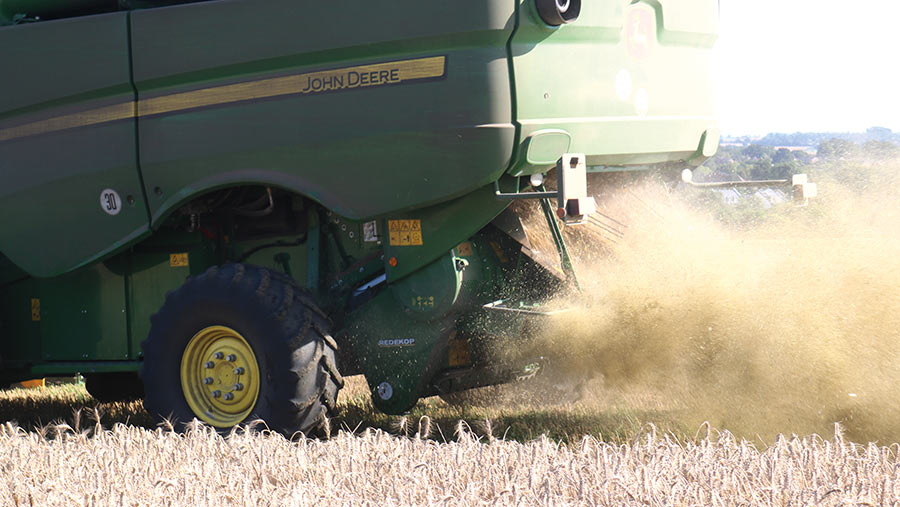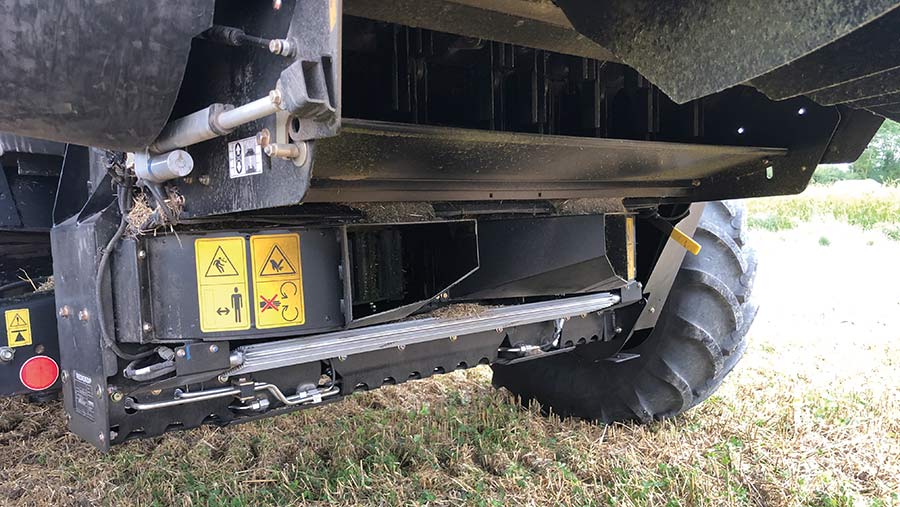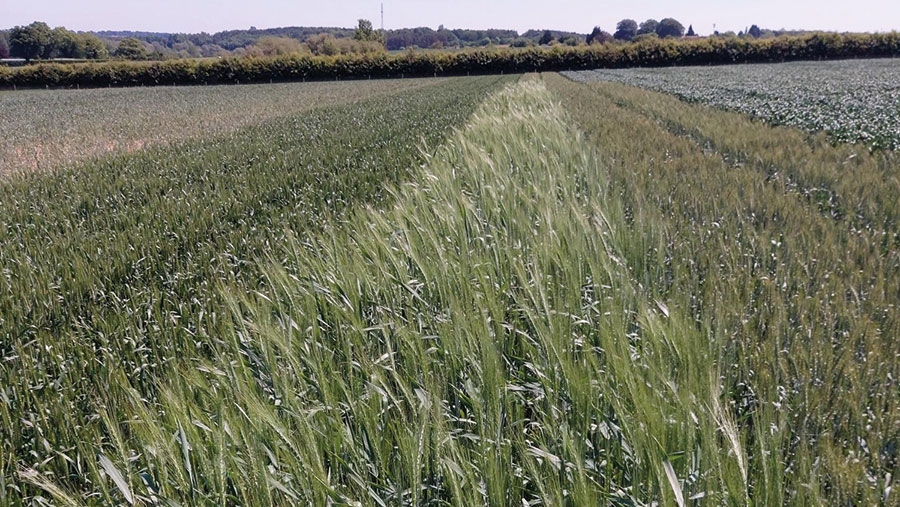How farmer trial will test Canadian combine weed seed destroyer
 © Tom Allen-Stevens
© Tom Allen-Stevens A group of UK farmers is taking part in a ground-breaking research project to test the effectiveness of harvest weed seed control units developed by a Canadian company.
This non-chemical approach has proved successful in controlling grassweed problems in other countries like Australia.
The farmer-led project will see three Redekop seed control units (SCU) imported from Canada, fitted to combines and tested this harvest, with results closely monitored by Niab weed scientists.
The Redekop SCU is used across Canada, the US and Australia, and mills the chaff to a fine dust, destroying up to 98% of harvested weed seeds, such as meadow brome and ryegrass (see “How harvest weed seed control works”, below).
See also: How to tackle brome and stop it becoming the new blackgrass
The UK trial was initiated by the British On-Farm Innovation Network (Bofin), a group of more than 200 farmers and scientists who carry out on-farm trials, keen to see whether the unit would add a valuable, non-chemical option to control here in the UK.
Alternative method?
“Harvest weed seed control isn’t currently considered as an option by UK growers,” says Niab senior trials manager Will Smith.
“But it could offer a valuable alternative control method, especially of herbicide-resistant weeds.
“Low-disturbance systems are currently highly reliant on glyphosate, and the SCU helps by preventing viable weed seeds from reaching the soil surface.
“So the data we’re capturing and the on-farm practice the farmers involved will be co-designing will become critically important if glyphosate loses its approval.”
The trial was initiated after Bofin and Niab were approached by Redekop importer Oria Agriculture.
How harvest weed seed control works
Australian farmer Ray Harrington is widely credited with pioneering a system that takes combine chaff and mills it to ensure weed seeds are unviable.
Initial versions of the Harrington Seed Destructor comprised an independently powered cart, towed behind the combine. Interest took off as Australian growers experienced increasing problems with glyphosate-resistant ryegrass.
“It was a great step forward, but a tow-behind cart with a second engine was a challenging concept for adoption,” says Redekop co-owner and president Trevor Thiessen.
The company, based in Saskatoon, Canada, was achieving global success with its MAV straw chopper and set its sights on a seed control unit to complement it, and a total residue management system for growers.
“We’d already put significant work into developing residue management systems, so looked to design a mill that was as seamless as possible – one that was easy on, easy off, so growers could bring it in and out of play with the minimum of fuss,” he says.
The mill itself is a step on from an integrated unit developed by researchers at the University of South Australia, funded by the Grains Research and Development Corporation.
“Researchers found if you hit a weed seed hard enough four times, it renders it unviable,” explains Mr Thiessen.
“Our design operates at 2,850rpm, passing the chaff at 400kph through two rotary sections of columns and three stationary sections. The tungsten-carbide coated mills are reversible to ensure a long life.”
Independent testing has found this kills up to 98% of the weed seed that passes through it.
“Like all mills, there’s a power requirement that can reduce combine speed by 10-12%. In drier conditions this may be closer to 5%. It requires up to 85hp in the sort of conditions and level of crop residue typical in UK cereal crops.”

Redekop SCU fitted to Case IH 7230 combine © Will Smith
Developed first for John Deere combines, units are also now available for newer Case IH, New Holland and Claas models and can be retrofitted.
Like the MAV chopper, it spreads residue across the full combine cut-width, although operates independently, so chaff can be milled and straw swathed, or vice versa, for example.
“The SCU is a tool farmers can use to future-proof their weed control system, as herbicide resistance grows and chemistry loses its approval for use.
“Farmers who use it say it’s a tool that can help them get on top of a weed problem before it gets on top of them,” concludes Mr Thiessen.
“We’ve seen the success of this technology in other places around the world and we are keen to evaluate its effectiveness in the UK.
“This year, we will see a significant increase of weed seed mills on combines in Europe, which is driven by the need to find alternative weed management solutions,” explains Oria’s Danea Armstrong.
The concept was put to Bofin members and strong interest came back from farmers keen to take part in an on-farm trial.
“We put in a bid for Defra/UKRI funding for a project under the Farming Innovation Pathways programme, but were unsuccessful.
“However, such was the interest in the trial, and due to the calibre of the farmers who came forward, we decided to proceed anyway.”
Three farmers
Three farmers were selected with compatible combines and a weed spectrum likely to give useful results.
Jake Freestone of Overbury Enterprises, in Worcestershire, is having his new John Deere S790 combine fitted with the unit to tackle a tricky problem with meadow brome.
In Suffolk, Adam Driver has found his Claas Lexion 8800 puts blackgrass seed into its chaff lines, so results from the SCU will be monitored closely to gauge the difference it makes.
For Ted Holmes, Velcourt farm manager in Warwickshire, ryegrass is grassweed enemy number one.
“We have increasing levels of resistance, and it’s become a real issue,” he says.
“We’ve looked closely at harvest weed seed control, but there simply aren’t enough systems on trial in the UK yet to give us a good idea of the control we could achieve.
“So we leapt at the chance to be involved in this trial.” He operates a New Holland CR9.90.
This keen interest was common among the dozens of other growers who came forward.
They have been brought together into a “knowledge cluster”, co-ordinated by Bofin, of more than 50 farmers, weed scientists and knowledge exchange managers who met at an introductory webinar.
The group will be given regular updates, will share experience and help shape the project, which may run for two years, depending on first-year results.
Initial trials
Niab has carried out initial work with a Redekop SCU fitted to the Case IH 7230 combine used by its farm near Cambridge during harvest 2021.
A 2ha field of Extase winter wheat infested with meadow brome and wild oats was chosen for the trial, says Mr Smith.
“There was quite a high burden of meadow brome that would have affected yield. We wanted to work out not just how effective the SCU was, but how much of the weed seed produced in the standing crop was passing through to the mill.”
He explains that meadow brome is a grassweed that sheds relatively little seed before harvest.
“Ryegrass is similar and very little data exists on either for how much of the seed that’s shed early is viable. Blackgrass tends to shed most of its seed before wheat is cut, however.”
Weed panicles were counted in a test area before harvest, with trays placed in the standing crop to assess the proportion shed.
Header losses were similarly assessed, and weed seeds found in the grain sample were counted.
“Based on these assessments, we calculated that, on average, 77% of the seeds were harvested and passed through the mill, although harvest was delayed due to weather.
“If the date was ideal, we’d expect this figure to be higher, but there’s always a proportion you’ll never capture” he points out.
Finally, an assessment was made of weed seedlings that germinated in the following crop.
“Overall, we found the SCU reduced the population by 83%,” reports Mr Smith.
“That indicates the mill actually captures more viable seed than the panicle counts would suggest, and this is one area we’re keen to look at in more detail in the new project.”
This summer
This harvest, the aim is to test the SCU in at least three fields of winter wheat at each farm to capture a range of harvest dates and a rich dataset.
Weeds will be assessed at four timings – a month before harvest, at harvest itself, then the stubble will be assessed as well as the following crop after autumn herbicide applications.
“It’s not just about the data, though,” he says.
“A key part of the project will be to gather the farmers’ views on using the seed mill – whether it holds harvest up, any technical problems, and the effect on power and fuel use, for instance.
“There’s also a theory that it can help no-till systems as it reduces the risk of building up a large, shallow weed seedbank.
“This is where interaction with the knowledge cluster will be key to tease out and explore elements of a very different approach to controlling grassweeds,” says Mr Smith.
- For more on the weed seed destruction knowledge cluster, which is free to join, go to bofin.org.uk
Farmers to trial ‘slug-resistant’ wheat
Farmers have been invited to take part in a trial of wheat that may be resistant to slugs.
Researchers at John Innes Centre have identified the potential trait in one of a diverse collection of landrace wheats currently being screened for properties of interest.
“We decided to screen some of the Watkins material for slug resistance as this was identified as a priority,” says Simon Griffiths of the John Innes Centre, who leads one of the work packages of the UKRI-funded Designing Future Wheat (DFW) programme.

© Simon Griffiths
Using a set of choice chambers that allows slugs to choose at random varieties they would like to graze and those they prefer to avoid, there was one wheat that stood out as consistently spurned – Watkins 788.
“We don’t know yet whether this wheat truly resists slugs or whether they’d still eat it in a field situation where there’s no other choice,” explains Prof Griffiths.
The concept was put to Bofin members in 2020 and considerable interest came back in conducting trials of 0.4ha plots of the wheat – the area required to provide the optimal foraging distance to study the slugs’ behaviour.
“On the strength of this initial interest, we’ve spent the past two years multiplying up enough seed, and we’re now ready to go,” he says.
The trials will start this autumn, closely monitored by John Innes Centre entomologists.
“If the wheat truly resists slugs, this will be a very valuable trait to pinpoint and bring into UK breeding programmes,” he adds.
“Long-term funding from Defra and Biotechnology and Biological Sciences Research Council [BBSRC] have given us the tools we need to identify the genetic basis of valuable pest resistance such as this.”
Although this may take many years, farmers and scientists will be invited into a Bofin knowledge cluster, keeping them closely involved in the project.
The aim will be to work with scientists to gain an insight into slug behaviour in the field and test strategies that will combat the pest in conjunction with genetic resilience.
Actual trials undertaken will be co-designed and decided by the farmers in the knowledge cluster, points out Prof Griffiths.
“The aim is to develop understanding of farming systems at the same time as developing the next generation of wheats,” he explains.
“This is a far more sustainable approach than traditional plant breeding where the two are developed in isolation.
“It’s made possible through the introduction of new plant-breeding techniques that considerably shorten the timespan it takes to bring a new trait to market.”

